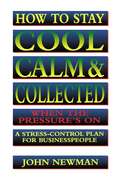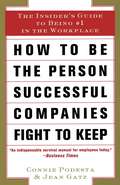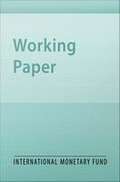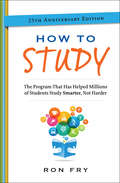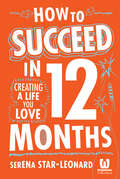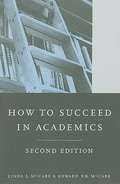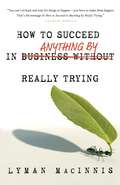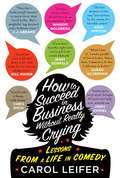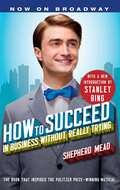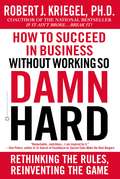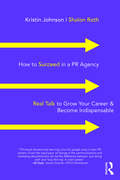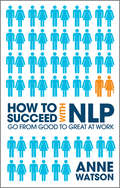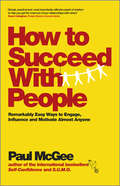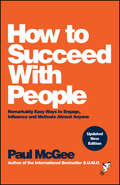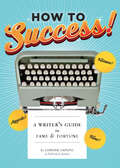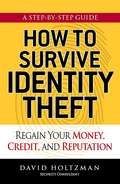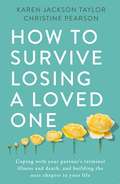- Table View
- List View
How to Startvand Build a Law Practice
by Jay FoonbergIf you have a question about starting and growing your own law practice, or improving your existing solo or small firm practice, Jay Foonberg has the answers in this power-packed, updated, and expanded new edition. <p><p>Learn it all from a practicing lawyer who provides you with real answers, for real practices, gained from real experiences. This classic ABA bestseller has been used by tens of thousands of lawyers as the comprehensive guide to planning, launching, and growing a successful practice. It’s packed with 769 pages of guidance on identifying the right location, finding clients, setting fees, managing your office, maintaining an ethical and responsible practice, maximizing available resources, upholding your standards, and much more. If you’re committed to starting your own practice, this book will give you the expert advice you need to make it succeed.<p><p>How the ABA’s #1 Bestseller Will Help YouThe book is organized into short, easy-to-read chapters and they deal with all the specific challenges you undoubtedly will encounter when you open your office. And the answers you’ll get are realistic, practical, and based on real-life experience. <p><p>Even if you already have an established practice, you are sure to find information that will help you compete and succeed. You’ll find a wealth of tips that can improve your practice once it is up and running, as well as dozens of time-saving templates and checklists. <p><p>In addition, there is all-new material for this edition, covering areas including: <ul><li>E-mail and the InternetLaw firm mergers and dissolutions</li> <li>Student loans</li> <li>Opportunities created by an aging population</li> <li>Nonlawyer consultants</li> <li>The globalization of legal practice, and much more! </li></ul> <p><p>This book is guaranteed to help you successfully launch your practice, run it at maximum efficiency, and avoid potential pitfalls along the way. You’ll get basic, practical advice given in Foonberg’s inimitable down-to-earth style–and answers to down-to-earth questions including: Where is the ideal place to open my office? How much cash do I need to start? How can I get cash up front to reduce bad debts?Should I charge for the first consultation? How do I spot the client who won’t pay? What kinds of equipment will I need–at a minimum–to start out?What are the most effective ways of getting clients?More than 100,000 lawyers have turned to Jay Foonberg for the secrets to running a successful law firm; now you can, too, with the acclaimed Sixth Edition.
How to Stay Cool, Calm and Collected When the Pressure's On: A Stress-Control Plan for Business People
by John NewmanPressures, problems, and conflicts are a fact of life. But the manager who can face problems head-on and deal with them calmly is way ahead of the game. How to Stay Cool, Calm & Collected When the Pressure's On offers a systematic approach to dealing with a world that often seems a chaotic confluence of tough decisions, difficult situations, and combative people. Written by a stress expert with a Ph.D. in organizational psychology, this antidote to stress and strain lays out a unique and powerful approach to making wise choices and taking actions that will put readers in control of any situation. <P><P>Once the author's "Command and Control" techniques are learned, they can be used again and again in all areas of life. Readers will learn how to: * destroy counterproductive, stress-producing habits * adopt new, effective habits * become mentally tough, emotionally in control * communicate in a positive way How to Stay Cool Calm & Collected When the Pressure's On provides checklists, quotes from stress conquerors, and an outline for a personal effectiveness plan. By carefully adhering to the book's principles, anyone can erase the ravages of stress and move on to a more productive, I-can-handle-any-problem attitude. Without the energy-wasting effort of worrying, readers can concentrate on the important things: achieving success and enjoying their lives.
How to Stay Employed in Tough Times
by Connie PodestaAt a time of decreasing organizational loyalty and a decline in long-term job security, CEOs, managers, and human resources directors reveal on-target answers to the question on the minds of employees everywhere: What does my boss want? Based on a national survey of more than 300 people, this succinct guide provides real-life advice regarding job security today.
How to Stay on Course: Sensing and Responding to Deviations from Plan
by Harvard Business Review PressNo action plan can foresee the many obstacles and changing conditions that people will face over the weeks and months it takes to implement a strategy. Thus, mid-course adjustments and management intervention are inevitable and necessary. This chapter offers suggestions for keeping implementation on course.
How to Stitch an American Dream: A Story of Family, Faith and the Power of Giving
by Jenny Louise DoanFaith, family, hard work, and second chances are at the core of every great American story, and Jenny Doan&’s story is just that. In her new memoir, How to Stitch an American Dream, readers will discover the behind-the-scenes success story of the Missouri Star Quilt Company and Jenny&’s remarkable journey to overcome hardship, claim the abundance of family, and ignite the power of giving—all while revitalizing a small town along the way. Over the last decade, the Doan family business, the Missouri Star Quilt Company in tiny Hamilton, Missouri, has grown from Jenny&’s corner shop--with one quilting machine and two bolts of fabric for sale in the back--to become the largest supplier of pre-cut quilting fabric in the headquarters of Jenny&’s world-famous YouTube tutorial videos. Jenny is now giving her fans, the business world, and moms of all ages (and grandmas too!) what they&’ve been asking for: the full story of her journey, from her humble beginnings as a homeschooling mom, to founding MSQC in her fifties, through the remarkable success and inspiration she&’s so well-known for today. In this book, you&’ll learn:How she and her beloved husband, Ron, raised seven children on a shoestring budget— and had fun doing it;How, after a string of bad luck, the family made a prayer-based decision to leave California behind and start over again in rural Missouri, even though they had no place to live, no jobs lined up, and no idea how they were going to make it;How Jenny, Ron and their children worked side-by-side to patch together a family home out of a crumbling shell of a farmhouse;And how their faith, hard work, and generosity not only carried them through the hard times, but led directly to the success of the Missouri Star Quilt Company.How to Stitch an American Dream will make you laugh, cry, say &“bless your heart.&”
How to Stop a Herd of Running Bears? Market Response to Policy Initiatives during the Global Financial Crisis
by Natalia Tamirisa Andreas Jobst Jochen Andritzky Sylwia Nowak Yacine Aït-SahaliaA report from the International Monetary Fund.
How to Study
by Ron FryThe bestselling How to Study (Seventh Edition) reveals the study skills that all students need to know in order to be successful, whether the goal is landing a top scholarship or excelling in school. This edition includes information on how to create an effective work environment, stand out in class, use the library, conduct research online, and much more. Plus, author Ron Fry covers all the traditional elements of a winning study strategy, such as reading, writing, time-management, memory, and test-taking skills. How to Study (Seventh Edition) introduces a revolutionary study system, along with examples, that gives students the edge in any learning environment.
How to Study: The Program That Has Helped Millions of Students Study Smarter, Not Harder (Ron Fry's How to Study Program #3)
by Ron FryThe bestselling guide that has helped millions of students study smarter, not harder—updated for today&’s classroom.How to Study reveals the study skills all students need to know to be successful, whether the goal is landing a top scholarship, excelling in school, or preparing to return to school. This edition includes information on how to create an effective work environment, stand out in class, conduct research online, and much more. Fry also covers all the traditional elements of a winning study strategy, such as reading, writing, time management, memory, and test-taking skills. How to Study introduces a revolutionary study system along with examples that give students the edge in any learning environment. How to Study also: Prepares students of all ages to excel in their classes by developing effective study skillsShows students, in a quick, easy-to-read style, the essential skills that can be applied outside the classroom and later in lifeIncludes study tips for teaching and studying with young children; advice for fighting mid-study fatigue and boredom; tips for in-class learning; and more
How to Succeed as a Scientist
by Jane A. Langdale Barbara J. GabrysThis unique, practical guide for postdoctoral researchers and graduate students explains how to build and perfect the necessary research tools and working skills to build a career in academia and beyond. It is based on successful training workshops run by the authors: first, it describes the tools needed for independent research, from writing papers to applying for academic jobs; it then introduces skills to thrive in a new job, including managing and interacting with others, designing a taught course and giving a good lecture; and it concludes with a section on managing your career, from how to manage stress to understanding the higher education system. Packed with helpful features encouraging readers to apply the theory to their individual situation, the book is also illustrated throughout with real-world case studies to enable readers to learn from others' experience. It is a vital handbook for everyone seeking to make a successful scientific career.
How to Succeed in 12 Months
by Serena Star-LeonardStep into the more fabulous version of your lifeThink about where you are in life right at this moment. How does it compare with your dreams? You may have let go of a few life goals over the years, as "real life" took over and made grand gestures seem like impractical fantasies. But no matter where you are on your life's journey, it's not too late to reclaim your dreams and achieve the life you've always wanted! It's absolutely possible to design your own lifestyle instead of just allowing circumstance to dictate your daily routine.How to Succeed in 12 Months: Creating a Life You Loveis your ultimate guide to turning your dreams into reality. Author Serena Star-Leonard is living the dream herself, having practiced what she preaches. In the book, she shares the secrets behind figuring out the steps that will get you the life you've always wanted, and taking those steps in leaps and bounds. It's not a get-rich-quick scheme, but a one-year plan to stepping out of your rut and into your most fulfilling life. Star-Leonard provides a roadmap to:Breaking your dreams into small, actionable stepsEliminating excuses and gaining confidencePrioritizing your goals for better planningDesigning your lifestyle around your interestsWhether you've been looking for a way to work closer to your dreams, or are just looking for a way out of the rat race, Star-Leonard is your guide to make big things happen. How to Succeed in 12 Months: Creating a Life You Love is the key that opens the door to a more fabulous version of your life.
How to Succeed in Academics
by Linda L. Mccabe Edward R. B. MccabeLinda L. McCabe and Edward R. B. McCabe, both professors at the University of California, Los Angeles, write clearly and accessibly, illustrating their main points with sample case scenarios.
How to Succeed in Anything by Really Trying
by Lyman MacinnisAn experienced executive himself, Lyman MacInnis has guided the careers and affairs of successful executives and entrepreneurs as well as internationally renowned entertainers and athletes.An inspiring and practical book of career advice for everyone, from executives and partners, to mid-career professionals and even graduates looking to get in on the ground floor.For anyone ready to work their way to the top, Lyman MacInnis delivers the essentials. Advising on topics from networking, leadership, conflict resolution, negotiation, to never embarrassing yourself when addressing a crowd, and even how to give and take advice, How to Succeed in Anything by Really Trying is a wonder of common sense and a wealth of simple knowledge.From the Hardcover edition.
How to Succeed in Business Without Really Crying
by Carol LeiferFor many years, television comedy was an exclusive all boys' club--until a brilliant comedian named Carol Leifer came along, blazing a trail for funny women everywhere. From Late Night with David Letterman and Saturday Night Live to Seinfeld, The Ellen Show, and Modern Family, Carol has written for and/or performed on some of the best TV comedies of all time. This hilarious collection of essays charts her extraordinary three-decade journey through show business, illuminating her many triumphs and some missteps along the way--and offering valuable lessons for women and men in any profession. Part memoir, part guide to life, and all incredibly funny, How to Succeed in Business without Really Crying offers tips and tricks for getting ahead, finding your way, and opening locked doors--even if you have to use a sledgehammer.
How to Succeed in Business Without Really Trying: With a New Introduction by Stanley Bing
by Shepherd MeadFrom this classic tome, learn everything you need to know to land the corner office: · How to make money · How to make more money · How to choose the right company (one big enough so that nobody knows exactly what anyone else is doing) · How to cultivate the appearance of extreme busyness through strategic desk management · How to delegate responsibility (have plenty of assistants!) First published in 1952, this guide inspired the beloved Pulitzer Prize–winning musical, which returns to Broadway in 2011 in a production that stars Daniel Radcliffe and John Larroquette. Updated with a brilliant new introduction by the king of business satire, Stanley Bing, How to Succeed in Business Without Really Trying is essential reading for the ambitious and the lazy alike.
How to Succeed in Business Without Working So Damn Hard: Rethinking the Rules, Reinventing the Game
by Robert J. KriegelMore breathing space, more time to think, and more of the joy that comes with great work and great ideas...this can be your work life! Bestselling author Robert J. Kriegel has been acclaimed as a truly innovative voice on the American business scene. Now the man who the New York Times said has "spurred a revolution in performance practices" challenges you to break out of old modes and mind-sets. The bold, innovative strategies discussed by Dr. Kriegel help you develop dramatic new solutions to old problems, create exciting new possibilities, and succeed beyond what you ever thought possible, without having to work so damn hard! Book jacket.
How to Succeed in Commercial Photography: Insights from a Leading Consultant
by Selina MaitreyaAfter more than thirty years in photography, an industry veteran speaks out in How to Succeed in Commercial Photography. These essays provide photographers at every level with all the tools they need for a great career. Author Selina Maitreya offers proven tips for focusing on client needs; building a team from today's marketing assistants, reps, and consultants; developing an online portfolio; self-promoting; and much more. Through up-close interviews, professional commercial photographers reveal the missteps they made in their work--and how others can avoid making the same mistakes. A special section explores how photographers can set goals, survive tough times, overcome creative blocks, and more. Anyone seeking a successful and well-balanced life as a commercial photographer needs a copy of this illuminating guide.
How to Succeed in a PR Agency: Real Talk to Grow Your Career & Become Indispensable
by Kristin Johnson Shalon RothLearning how to be successful in a public relations (PR) agency is a stressful on-the-job, sink-or-swim, immersive experience. While other texts teach PR theory and practice, no other book guides early to mid-career PR professionals through the day-to-day life of working in an agency and the skills required to excel and build a career. This text demystifies the PR agency experience with foundational information to simplify and clarify agency life. Authors Kristin Johnson and Shalon Roth, who each grew successful careers in PR agencies, share secrets that no one will teach in a class or a seminar. This is real talk about real life in an agency – punctuated by anecdotes from leaders in the industry. This is a must-read for communications students and PR professionals looking to grow their career and become indispensable to teams and clients.
How to Succeed in the Face of Failure: Palm Pilots and Counterproductive Carrots-Making Intersectional Ideas Happen
by Frans JohanssonMistakes and false starts are part of the process for making ideas happen at the intersection of cultures, disciplines, and fields. If we hope to innovate, we must continue executing ideas and move past our failures.
How to Succeed with NLP
by Anne WatsonThink like the best and succeed like the best Ever wondered how some people always manage to succeed? Well wonder no longer, How to Succeed with NLP examines exactly how those people do it and breaks down everything you need to know to emulate their success. This energising book shows you how to change your mindset and alter your behaviour to become the most valuable asset in your company. The NLP techniques will provide any ambitious, eager person with the perfect toolkit to get ahead. You will learn how to; increase your confidence, improve your influencing skills, handle conflict situations, dispel anxious feelings, trust your intuition, create a rapport with others, be more effective in your communication, understand and use body language, define the results you want and set about achieving them.
How to Succeed with People
by Paul McgeeLearn to be a people person with international bestselling author Paul McGee!Let's face it, if you want any sort of success in life you're going to have to deal with other people at some point. All success requires input from other people - even if you've invented something in your bedroom, eventually, you're going to need to interact with people to take it to the next level. And even if you don't desperately hanker after success, you surely want to be liked, have friends, get on well with people? Learning how to better communicate and interact with others can really help to improve your life - from ensuring you enjoy parties more to turning you into a roaring success magnet. So whether you dread social events with a passion and spend evenings cringing in a corner, or just want to have better relationships at work and in life, then How to Succeed With People, written in Paul's characteristic down to earth, approachable style, can help you become a people magnet.Learn how to:Hold people's attention when you talkListen and react properly to what others are saying or doingBetter confront, complain and deal with difficult conversationsGive compliments and praiseDeal with interviews, networking events, difficult conversations and moreAnd much more
How to Succeed with People: Remarkably Easy Ways to Engage, Influence and Motivate Almost Anyone
by Paul McGeeTake your people skills to the next level with this easy-to-follow, step-by-step guide Let’s face it. If you want any sort of success in life, you’re going to have to deal with other people at some point. It’s also the only way to make friends, meet new colleagues, and even find your special someone. So, why does dealing with other people seem so difficult sometimes? In the newly revised second edition of How to Succeed with People: Remarkably easy ways to engage, influence and motivate almost anyone, bestselling author and international keynote speaker Paul McGee delivers yet another exciting and inspiring guide to improving your communication skills and transforming how you interact with others. You’ll learn how to get over your dread of social events and create better relationships at work and in life, as well as: Strategies for holding people’s attention when you talk and how to listen and respond appropriately to what others are saying or doing Improve your ability to confront and challenge difficult people in and outside work Develop your skills around how to empathise and support people in tough times A can’t-miss guide on how to boost your understanding of people and your success in dealing with them, this book is perfect for young professionals, managers, executives and supervisors. How to Succeed With People will also prove invaluable in helping your relationships outside of work - from dating to parenting, and from motivating others to difficult conversations. With this book, you can have immediate and actionable advice at your fingertips.
How to Success!: A Writer's Guide to Fame & Fortune
by Corinne CaputoA clever writing self-help parody that skewers writers’ guides while offering amusing, almost-helpful advice.This parody self-help book for writers is filled with hilariously misguided tips, factual-looking charts, and other advice that knowingly pokes fun at writerly foibles while still cheering would-be authors on. With this book, struggling writers can find suggestions for effective paragraph shapes, tips on where to find inspiration (in your reflection, in the shapes of gum stuck to the ground, in a consultation with your doctor), thoughtful poses for author photos, pull-out procrastination excuses, and much more. How to Success! is filled with enough almost-helpful advice to keep aspiring writers amused, unblocked, and on their way to literary fame.“How to Success! lightens the pressure many creatives put on themselves to succeed. In effect, it acts as a mirror, showing readers how silly and elusive writing—and writers—can be. Caputo offers practical advice with a comedic twist that will have you laughing out loud.” —Failure Magazine
How to Survive Identity Theft
by David HoltzmanIdentity theft is at an all-time high. In one notorious case, a criminal racked up more than $100,000 of debt in the name of his victim. The thief bought homes, motorcycles, and handguns in the victim's name. The victim and his wife spent more than four years and $15,000 to clear his name.Money, credit, and even lives are at stake when an identity is stolen. Yet many people don't know what legal protections exist. You need to learn what to do when your name, credit card number, or other information gets into the wrong hands. Security expert David Holtzman offers you clear, concise advice on how to reduce the chances of fraud and what steps victims need to take to reclaim their lives. An extensive resource list offers tools to draw up a plan to rebuild credit and reputation.Thieves are roaming the Internet. But with this essential guide, their victims can even the score!
How to Survive Identity Theft: Regain Your Money, Credit, and Reputation
by David HoltzmanIdentity theft is at an all-time high. In one notorious case, a criminal racked up more than $100,000 of debt in the name of his victim. The thief bought homes, motorcycles, and handguns in the victim’s name. The victim and his wife spent more than four years and $15,000 to clear his name.Money, credit, and even lives are at stake when an identity is stolen. Yet many people don’t know what legal protections exist. You need to learn what to do when your name, credit card number, or other information gets into the wrong hands. Security expert David Holtzman offers you clear, concise advice on how to reduce the chances of fraud and what steps victims need to take to reclaim their lives. An extensive resource list offers tools to draw up a plan to rebuild credit and reputation.Thieves are roaming the Internet. But with this essential guide, their victims can even the score!
How to Survive Losing a Loved One: A Practical Guide to Coping with Your Partner's Terminal Illness and Death, and Building the Next Chapter in Your Life
by Christine Pearson Karen Jackson TaylorA practical, empowering guide to navigating your partner's diagnosis of a terminal or life-limiting illness, or death. Receiving the news that your partner has a terminal or life-limiting illness, or has died unexpectedly, is among the worst experiences in life. At a time when you are least able to cope, you are faced with a multitude of difficult decisions, some of which must be made quickly. What you need is a friend who has experienced everything you are about to face, who can support you as you navigate some tough, important choices. This book is that friend. There is plenty of information out there but where to start looking? What information is needed and how can it be accessed? What decisions are essential in the immediate term and what can be left until later? Throughout the book, the emphasis is on protecting and supporting those left behind by presenting almost every choice you may need to make and the possible implications of each decision. You will learn:- The importance of creating a will, arranging power of attorney, organising advanced decisions of treatment, and even getting married or entering a civil partnership- What you are entitled to from the state, the NHS and your employer- How to stabilise your finances and prepare to run a household alone- Where your partner ought to be during treatment and/or palliative care, and how to go about achieving this- Which decisions need to be made after death, from planning the funeral to accessing your partner's estate- How to navigate the grieving process and take control of a happy future No matter where you are in the process, How to Survive Losing a Loved One is a comprehensive, practical and empowering guide to coping with your partner's terminal illness and death, and building the next chapter in your life.

